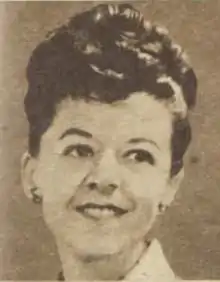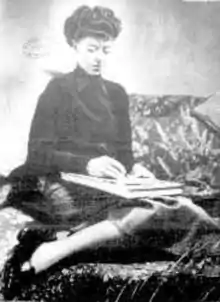Peggy Glanville-Hicks
Peggy Winsome Glanville-Hicks (29 December 1912 – 25 June 1990) was an Australian composer and music critic.

Biography
Peggy Glanville Hicks, born in Melbourne, first studied composition with Fritz Hart at the Albert Street Conservatorium in Melbourne. There she also studied the piano under Waldemar Seidel. She spent the years from 1932 to 1936 as a student at the Royal College of Music in London, where she studied piano with Arthur Benjamin, conducting with Constant Lambert and Malcolm Sargent, and composition with Ralph Vaughan Williams. (She later asserted that the idea that opens Vaughan Williams' 4th Symphony was taken from her Sinfonietta for Small Orchestra (1935), and it reappears in her 1953 opera The Transposed Heads).[1] Her teachers also included Egon Wellesz, in Vienna, and Nadia Boulanger, in Paris.
She was the first Australian composer whose work, her Choral Suite, was performed at an International Society for Contemporary Music (ISCM) Festival (1938).
From 1949 to 1955 she served as a critic for the New York Herald Tribune, succeeding Paul Bowles, working under Virgil Thomson. At the same time she continued composing and was musical director at the Museum of Modern Art in New York.[2] She was granted U.S. citizenship in 1949.[3] After leaving America, she lived in Greece from 1957 to 1975. In the United States she asked George Antheil to revise his Ballet Mécanique for a modern percussion ensemble for a concert she helped to organize.[4] In 1966, after years of failing eyesight, she was diagnosed with a brain tumour, which was surgically removed, and she regained her sight. However, a result of this operation was her loss of a sense of smell.
She died in Sydney in 1990. She had returned to Australia at the encouragement of James Murdoch and others. Murdoch also wrote her biography. Her will established the Peggy Glanville-Hicks Composers' House in her home in Paddington, Sydney, as a residency for Australian and overseas composers.[5] The organisation New Music Network established the Peggy Glanville-Hicks Address in her honour in 1999.[6]
Music
Her instrumental works include the Sinfonia da Pacifica (in three short movements, begun in 1952 on a boat traveling from New Orleans back to her home in Australia, and premiered in Melbourne the following year); the Etruscan Concerto for piano and orchestra, championed in 1992 by Keith Jarrett;[7] Concerto romantico for viola and orchestra; and the Sonata for Harp, premiered by Nicanor Zabaleta in 1953; performed by Marshall McGuire on the CD Awakening, the work was named the Most Performed Contemporary Classical Composition at the APRA Music Awards of 1996.[8]
Her best known operas are The Transposed Heads and Nausicaa. The Transposed Heads is in six scenes with a libretto by the composer after Thomas Mann, and was premiered in Louisville, Kentucky, on 3 April 1954.[9] Nausicaa was composed in 1958–60 and premiered in Athens in 1961. The libretto is from the novel Homer's Daughter by Robert Graves and supports the theory that The Odyssey, attributed to Homer, is actually a story told by women. Glanville-Hicks visited Graves on Majorca in 1956 and worked with his friend Alastair Reid to complete the libretto.[10] The premiere was a major event in the operatic calendar, and was considered a triumph for Glanville-Hicks, but the opera has never been re-staged.
Her last opera, Sappho, was composed in 1963 for the San Francisco Opera, with hopes that Maria Callas would sing the title role. However, the company rejected the work and it has never been produced.[11] This opera was recorded in 2012 by Jennifer Condon conducting the Gulbenkian Orchestra and Coro Gulbenkian with Deborah Polaski in the title role.
Private life
She was married to British composer Stanley Bate, who was homosexual,[12] from 1938 to 1949, when they divorced.[13] She married journalist Rafael da Costa in 1952; the couple divorced the following year.[14] She was also involved with Mario Monteforte Toledo and Theodore Thomson Flynn.[15] Like Bate, many of the men with whom Glanville-Hicks was close were gay; she had few intimate female friends, and often dressed in male attire.[16] She was an intimate friend of the expatriate U.S. writer and composer Paul Bowles, and they remained very close all their lives, although their relationship was mainly epistolary after his move to Morocco in 1947. She set some of his letters to orchestral accompaniment in Letters From Morocco.[17]
Works

- Three Songs (1931)
- Caedmon, opera (1933)
- Mimic Heaven, Five Songs by A.E. Housman (1944)
- Profiles from China, 5 miniature songs (1945)
- Concertino da camera (1946)
- Thirteen Ways of Looking at a Blackbird, song (words Wallace Stevens) (1948)
- Letters from Morocco, for tenor and small orchestra (words Paul Bowles) (1952)
- Sonata for Harp (1952)
- Sinfonia da Pacifica (1952–1953)[18]
- The Transposed Heads. A Legend of India, opera after the novel Die vertauschten Köpfe by Thomas Mann (1953)
- Three Gymnopedies, for oboe, celeste, harp, strings (1953)[19]
- Etruscan Concerto, for piano and chamber orchestra (1956)
- Concerto Romantico, for viola and chamber orchestra (1956)
- The Glittering Gate, opera (1957)
- The Masque of the Wild Man, ballet (1958)
- Prelude for a Pensive Pupil, for piano (1958)
- Nausicaa, opera (1961)
- Sappho, opera, (1963), produced 2012.
- Saul and the Witch of Endor, television ballet (1964)
- Tragic Celebration (Jephtha's Daughter), ballet (1966)[18]
References
- Rogers 2009, p. 30.
- "Interesting Women in the News They Are Trying for Political Honours". Sunday Herald (Sydney, NSW). 3 August 1952. p. 18. Retrieved 25 October 2018.
- Covell, Roger. "U.S. Citizen but the Music is Australian". The Sydney Morning Herald Weekend Magazine, 13 June 1970.
- American Mavericks, Program Notes
- "Peggy Glanville-Hicks Composers' House Trust". Retrieved 25 March 2016.
- The Peggy Glanville-Hicks Address Archived 28 February 2016 at the Wayback Machine, New Music Network
- 20th Century Piano Concertos, MusicMasters (re-issued 2020, from 1992 recording)
- "1996 Winners – APRA Music Awards". Australasian Performing Right Association (APRA) | Australasian Mechanical Copyright Owners Society (AMCOS). Archived from the original on 18 September 2009. Retrieved 11 September 2018.
- Radic, Thérèse (1992). "Transposed Heads, The". The New Grove Dictionary of Opera. Online version retrieved 1 March 2018 (subscription required for full access).
- "Peggy Glanville-Hicks (1912–1990) : Represented Artist". Australian Music Centre. Retrieved 3 January 2023.
- "Buried symphonies score a chance at resurrection", The Age, 27 July 2007.
- Commire, Anne; Klezmer, Deborah (1999). Women in World History: A Biographical Encyclopedia. Vol. 6. Yorkin Publications. p. 276.
- "Papers of Peggy Glanville-Hicks MS9083". Retrieved 9 August 2007.
- Robinson, Suzanne (2007). "Glanville-Hicks, Peggy Winsome (1912–1990)". Australian Dictionary of Biography. Vol. 17. National Centre of Biography, Australian National University. ISSN 1833-7538.
- Murdoch, James (2002). Peggy Glanville-Hicks: A Transposed Life. Pendragon Press. p. 109. ISBN 9781576470770.
- Rogers 2009, p. 50.
- 'Peggy Glanville Hicks: The Songs', reviewed at MusicWeb International
- Pioneers of a Century, BBC Concert Orchestra performance, 8 March 2021
- Deborah Hayes. "Glanville-Hicks, Peggy." Grove Music Online. Oxford Music Online. Oxford University Press. Retrieved 18 October 2017. (subscription required)
Sources
- Rogers, Victoria (2009). The Music of Peggy Glanville-Hicks. Ashgate Publishing. ISBN 9780754666356.
Further reading
- Beckett, Wendy (1992). Peggy Glanville-Hicks. Pymble, NSW: Angus & Robertson. ISBN 0-207-17057-6.
- Hayes, Deborah (1990). Peggy Glanville-Hicks : A Bio-bibliography. New York: Greenwood Press. ISBN 0-313-26422-8.
- Robinson, Suzanne (2019). Peggy Glanville-Hicks, Composer and Critic. Urbana: University of Illinois Press.
External links
- Glanville-Hicks, Peggy (1912–1990) at The Encyclopedia of Women and Leadership in Twentieth-Century Australia
- Peggy Glanville-Hicks at IMDb